





It's almost time to order and plant bulbs to bloom in your garden next spring. Daffodils grow at historic sites throughout the south, long after the gardeners who planted them are gone. Here I will discuss daffodils and how and why to plant them.
The best way to plant daffodils is by the bushel. If you have an orchard of deciduous fruit or nut trees or a sort of wild place that gets at least 6 hours of full sun and does not need to be mowed constantly, that would be the perfect place to plant a few bushels of daffodils. Get the children, or borrow some from the neighbor. Let them throw the daffodils as naturalistically as they can. Just make sure that the bulbs are at least 6 inches apart and arranged in a random pattern. Then get a bulb augur and fit it to your cordless drill. Zap. Zap. Drill the holes about 8 inches deep. Drop in the bulb with the pointed end up, seat it firmly in the hole with a twist, then kick in the dirt you took out and tread the dirt firmly back in the hole. Preferably, all of this will take place within a day of a good drenching rain. If you are planting early, middle, and late varieties, repeat this process for each type you plant.[1]
Early, middle, and late varieties can be selected to provide a show for two months or more in the early Spring. Some vendors sell a naturalizers mix, that will provide a display of early to late season daffodils.[2] Here in Alabama, the daffodil season starts in February, with paperwhites, and ends about mid-May with the poets daffodils.
If you don’t have the means to plant a few acres of your place to daffodils, it's all right to plant just a few in borders or clumps here and there in the flower beds. Just don’t plant them in a straight row, like soldiers standing at attention. Daffodils need excellent drainage, and they need to be left alone, away from mowing machines. Their foliage needs to ripen until late summer in order to feed the bulbs for the following year's blooms. Their only real enemy is the mowing machine. Squirrels don’t like them, since they contain a trace of arsenic. Squirrels will, however, plant trees in the daffodil fields making a weedy mess if the seedling trees are not grubbed out periodically.
Other spring bulbs, such as camassia, chinodoxa, crocus, wood hyacinth (Hyacinthoides hispanica), ixiolirion, muscari, or squill, can be inter-planted in drifts with the daylilies. Some companion plants for daffodils are discussed in this thread.
In old Southern gardens the daffodils were over-planted with daylilies such as Kwanso daylilies, (Hemerocallis fulva 'Kwanso' (photo center, below) to hide the ripening foliage. Early summer bulbs, such as Allium caeruleum (right, below), can be used to complement the Kwanso daylilies. One of my favorite "blues" to go with daffodils is Camassia quamash (left, below.) This is Camassia scilloidoes, wild hyacinth, growing wild in Scott County Kentucky.
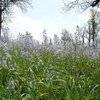
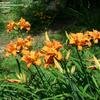
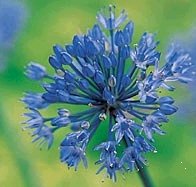
Some daffodils, especially the Tazetta daffodils, or paperwhites, can be forced into bloom as indoor flowers in the winter.[3] Many of them have a very unpleasant odor that can bring tears to your eyes. In this thread is a list of paper white cultivars with a less obnoxious odor.
The American daffodil Society has classified daffodils or Narcissus into 13 divisions: (1) trumpet, (2) large or long cupped, (3) small cupped, (4) double, (5) tiandrus, (6) cyclamineus, (7) jonquilla, (8) tazetta, (9) poeticus, (10) bulbocodium, "hoop petticoat form", (11) split cupped, (12) miscellaneous, and (13) species and wild daffodils.[4]
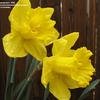
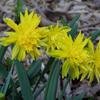
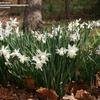
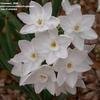
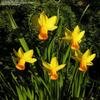
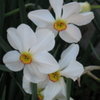
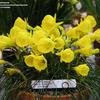
Left to right these are 'King Alfred' (Trumpet Narcissus), 'Rip Van Winkle' (Double Narcissus), 'Thali'a (Triandus Narcissus), Paperwhite 'Ziva' (Tazetta Narcissus), Narcissus cyclamineus 'Jetfire', Narcissus 'Poeticus', and Narcissus bulbocodium 'Obesus'.
The miniature daffodils are tiny versions of the 13 main divisions. They can be planted in rock gardens, children’s gardens, or in courtyard pots.
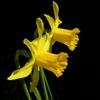
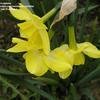

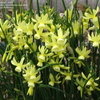
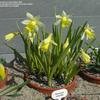
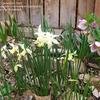
Miniature N.cyclamineus 'Tête-à-Tête', N. jonquilla 'Pipet', N. cyclamineus 'February Gold', N. triandrus 'Hawera', N. trumpet 'Topolino', and N. cyclamineus 'Toto'.
So, why plant daffodils? They invite you to explore the entire genre of spring blooming bulbs. You can't plant just one. You need companions. And, you need to extend the season. When you plant daffodils you are planting for your children, and for their grandchildren. Because daffodils, like diamonds, are forever.
[1] Suite 101 tutorial on planting daffodils
[2] VanEnglen, naturalizer's mix
[3] Forcing paperwhites
[4] Classification of Narcissus Divisions
(Editor's Note: This article was originally published on September 19, 2007. Your comments are welcome, but please be aware that authors of previously published articles may not be able to promptly respond to new questions or comments.)
Copyright © www.100flowers.win Botanic Garden All Rights Reserved